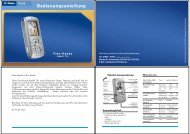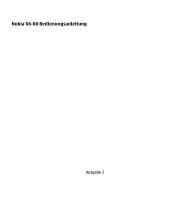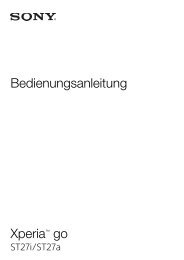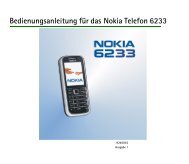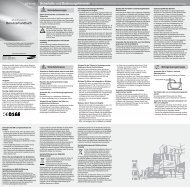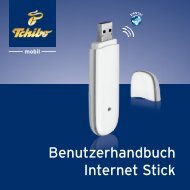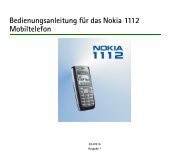Nokia 100 User Guide
Nokia 100 User Guide
Nokia 100 User Guide
Create successful ePaper yourself
Turn your PDF publications into a flip-book with our unique Google optimized e-Paper software.
If you have any questions about using your<br />
wireless device with an implanted medical<br />
device, consult your health care provider.<br />
Hearing<br />
Warning: When you use the headset,<br />
your ability to hear outside sounds may be<br />
affected. Do not use the headset where it can<br />
endanger your safety.<br />
Some wireless devices may interfere with<br />
some hearing aids.<br />
Operating environment<br />
This device meets radio frequency exposure<br />
guidelines in the normal use position at the<br />
ear or at least 1.5 centimetre (5/8 inch) away<br />
from the body. Any carry case, belt clip, or<br />
holder for body-worn operation should not<br />
contain metal and should position the device<br />
the above-stated distance from your body.<br />
To send data files or messages requires a<br />
quality connection to the network. Data files<br />
or messages may be delayed until such a<br />
connection is available. Follow the separation<br />
distance instructions until the transmission is<br />
completed.<br />
Vehicles<br />
Radio signals may affect improperly installed<br />
or inadequately shielded electronic systems in<br />
motor vehicles such as electronic fuel<br />
injection, electronic antilock braking,<br />
electronic speed control, and air bag systems.<br />
For more information, check with the<br />
manufacturer of your vehicle or its equipment.<br />
Only qualified personnel should install the<br />
device in a vehicle. Faulty installation or<br />
service may be dangerous and may invalidate<br />
your warranty. Check regularly that all<br />
wireless device equipment in your vehicle is<br />
mounted and operating properly. Do not store<br />
or carry flammable liquids, gases, or explosive<br />
materials in the same compartment as the<br />
device, its parts, or accessories. Remember<br />
that air bags inflate with great force. Do not<br />
place your device or accessories in the air bag<br />
deployment area.<br />
Potentially explosive environments<br />
Switch off your device in any area with a<br />
potentially explosive atmosphere, for<br />
example near gas pumps at service stations.<br />
Sparks in such areas could cause an explosion<br />
or fire resulting in bodily injury or death.<br />
Observe restrictions in fuel service stations,<br />
storage, and distribution areas; chemical<br />
plants; or where blasting operations are in<br />
progress. Areas with a potentially explosive<br />
atmosphere are often, but not always, clearly<br />
marked. They include areas where you would<br />
be advised to turn off your vehicle engine,<br />
below deck on boats, chemical transfer or<br />
storage facilities and where the air contains<br />
chemicals or particles such as grain, dust, or<br />
metal powders. You should check with the<br />
manufacturers of vehicles using liquefied<br />
petroleum gas (such as propane or butane) to<br />
determine if this device can be safely used in<br />
their vicinity.<br />
Certification information (SAR)<br />
This mobile device meets guidelines for<br />
exposure to radio waves.




